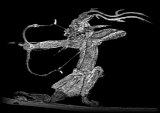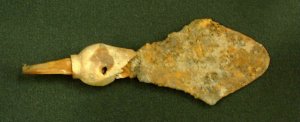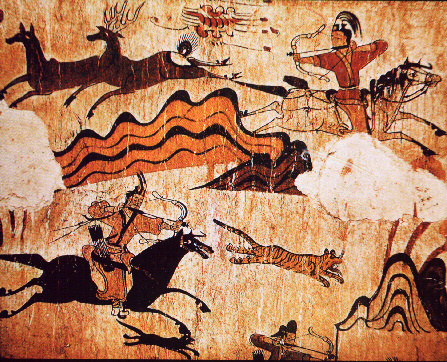

Whistling Arrows and Arrow Whistles © Liao Wanzhen, Trans. Stephen Selby, 1999
A number of names have been given to the whistling arrow in the Chinese
language. (Note: ‘whistling arrows’ here refers to arrowheads bearing both
a whistle mechanism and a sharp point.) The earliest literary record of such arrows
is to be found in the ‘Annals of the Huns in the ‘Historical Annals’ of
Sima Qian . (![]() )
)
"Miedun (
This record gives us a clear indication that Miedun was the first person to make the whistling arrow into an instrument for directing battle. In fact, Miedun owed his ability to seize the Khanate to his successful direction of his troops using whistling arrows.
"I still recall the blood smeared on the whistling arrow" is a line of poetry by Xin Qiji (1140-1207) recalling the whistling arrow which killed his father. Miedun must have been an outstanding leader of the Huns as can be seen from his his defeat of the Donghu in the east, pursuing the Yueshi in the west, driving out Loufan and King Baiyang of Henan in the south and besieging Emperor Gaozu of the Han (Liu Bang) at Ping Cheng so that he was unable to escape. Finally, the Chinese had to change to tactics of appeasement. You can see from this what an extraordinary character Miedun was. In that powerful eastward and westward expansion of the Huns, Miedun’s whistling arrows must have played an important part. That was the period in which the whistling arrow must have developed and become standardized.
What the design of the Hun whistling arrow was I cannot tell, despite the fact that I have seen and collected so many whistling arrows.
In my own collection of arrowheads I have quite a few whistling arrows; but apart from five or six bone ones, the rest are all iron and there is not a single bronze one among them. Obviously, my examples are early; but the earliest among them, dating from the Han or pre-Han period (i.e. before 220 AD), cannot be described as whistling arrows: rather they are whistles (without sharp points) for use on arrows. I shall refer to these as ‘Arrow Whistles’. This points to the origin of the development of whistling arrows starting before the Han Dynasty, because arrow whistles are a stage in the development of whistling arrows. The earliest discoveries are of arrow whistles, followed later by whistling arrows.
In fact, arrow whistles and whistling arrows are regarded by most people as one and the same thing. But there is a difference: actually, they are two different things and you can see the difference by comparing them side-by-side.
 |
|
Whistling Arrow |
Arrow Whistle |
A whistling arrow has a sharp point and can be a lethal projectile. An arrow whistle has a whistle but no sharp point. The whistle element of a whistling arrow can have three, four or even five apertures and, constrained by the presence of the sharp point, the whistle sounding box is often small. An arrow whistle, on the other hand, is often larger with more holes and a broader profile head-on. They can be made of bronze, iron, wood, bone, horn and with a louder sound, their signalling power is clearer than that of whistling arrows.
I have shown this very clearly by experimentation. Making my own reproductions of whistling arrows and arrow whistles, the arrow whistles were always clearer. My designs are different from some of the ancient designs because I have increased the size of the whistle chamber. (I have to do that because the power of the modern bows is not as great as the ancient ones and so the range and speed of the arrows is correspondingly lower. But the principles I adopted in the construction of the sound chambers and whistle blades were the same as in the originals.)
There was another big difference between whistling arrows and arrow whistles. That is in their usage.
Arrow whistles were purely signalling mechanisms and were only used in internal exercises or between friendly forces or allies. They were designed for shooting over a long distance at a high altitude and would not hurt anyone. In the ‘Tales of the Water Margin’, the story of ‘Zhu Gui firing a signal arrow at the water pavilion’ refers to an arrow whistle.
A whistling arrow, on the other hand, was intended for firing at the enemy, while also being able to give a signal. The shooting distance was short and it could generally be used in the battlefield. It was principally a method of conveying battle command signals.
A whistling arrow was a signal arrow. Even without the story of Miedun, you can see this clearly from examining the arrows themselves. I have a number of whistling fire arrows: their signalling purpose is obvious. Below the whistle mechanism there are sometimes forward-pointing iron prongs, designed to carry cotton or a coil of cord impregnated with oil . The battlefield situation calls for a concentration of fire and it is especially difficult to allow the troops to see the angle and target of fire in the confused conditions of battle. But using fire and whistling sounds these factors become easier to judge. Especially at the onset of battle, with the initial charge, the whistling arrow indicated the direction of the attack and the whistling arrow was a natural tool in the hands of the battle commanders.
All whistling fire arrows, it seems, were made of iron. There are no bronze ones. The different designs are numerous, however. Some have sharp points while others do not. Some have one set of iron barbs and others have two sets. Most of the whistle mechanisms were basically the same, and varied little over time.
Fire Arrow (Jin Dynasty) |
The first record of fire arrows comes from the Three Kingdoms (220-265). The Wei general Chi Shao used fire arrows against Zhuge Liang and in attacking Chen Cang’s observation ladder. The fire arrows in my collection could not be as early as that because they were all collected from the areas beyond the borders outside the Great Wall, most of them dating from the Jin Dynasty (1127-1279) and Tangut Kingdom.
Curiously, all the whistling arrows and arrow whistles I have been able to collect come from over the borders. Most of them were collected to the north or south of Yinshan. Needless to say, these are all relics of the battles of the nomadic border tribes. Who knows how many battles were fought in the region of Yinshan and along the line of the borders? It’s hardly surprising that in Zuo Si’s (c. 250 - c. 305) ‘Ode to History’, he wrote, "Whistling arrowheads rust along the border; shreds of fletching are blown into the Capital."
All that is not to say that there are not whistling arrows to be found in Central China. After all, where did events recorded in poetic lines like "Raising my bow and loosing a speedy whistling arrow, I spur my horse on into the Southern Mountains" (Cao Zhi, (192-232)) and "A whistling arrow beyond the clouds, enough to shake the spirit even of the brave" (Sun Guangxian (900-968)) come from?
In fact, the areas reached by the whistling arrow were very great, both inside and outside the Great Wall, and north and south of the Yellow River. They pervaded all areas and were even found in the furthest reaches of Tibet, in the grave of King Guge. As one of the most advanced weapons in the period before the advent of firearms, whistling arrows passed beyond the borders of China - principally to Korea and Japan.

That unusual sounding weapon, the whistling arrow, was a source of pride to our ancestors because of its unfading place in the pages of Chinese military history and China’s foreign wars.
09 October, 2000